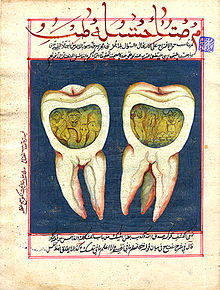The idea of a tooth worm is a theory of the cause of dental caries, periodontitis and toothaches. Once widespread, the belief is now obsolete, having been superseded by more scientific rationales. It was supposed that the disease was caused by small worms resident within the tooth, eating it away.[1]

History
editThe origins of the belief are wrapped in obscurity.[2] A prominent early mention, a Babylonian cuneiform tablet titled "The Legend of the Worm" (sometimes erroneously dated to Sumerian times[3]), recounts how the tooth worm drinks the blood and eats the roots of the teeth – causing caries and periodontitis:
"After Anu [had created heaven],
Heaven had created [the earth],
The earth had created the rivers,
The rivers had created the canals,
The canals had created the marsh,
(And) the marsh had created the worm—
The worm went, weeping, before Shamash, his tears flowing before Ea: "What wilt thou give for my food? What wilt thou give me for my sucking?"
"I shall give thee the ripe fig, (and) the apricot."
"Of what use are they to me, the ripe fig and the apricot? Lift me up and among the teeth and the gums cause me to dwell! The blood of the tooth I will suck, and of the gum I will gnaw its roots!"[4]
Accounts are also found in the Central American legends of Popol Vuh. The belief persisted into the 18th century, only being disproven by the microscopical endeavors of M. Pierre Fauchard.[5] Modern veterinary practice shows that when removed intact, the necrotic or partially necrotic tooth pulp can have an appearance like that of a worm.[6]
Sinhalese Charm for toothache:
Ira deyené asyā!
Sanda deyené aeyā!
Passé Buduné acyā!
Daté nositoo dat aeyā!
Worm of the sun-god!
Worm of the moon god!
Worm of the Passé Buddha!
Stay not in the tooth, thou tooth-worm![7]
Evidence
editAlthough no rigorous evidence was ever found, some practitioners believed the pulpal tissue within the root of the tooth to be a worm. Most however admitted to have never encountered a worm in vivo, but nonetheless encouraged the belief among the general public.
A 2009 study by the University of Maryland Baltimore using micro imaging revealed worm-like structures within a dissected molar. While not worms or caused by worms, these structures may have given rise to the tooth worm belief.[8] It is unclear what these structures are or what caused them.
References
edit- ^ Gerabek WE (March 1999). "The tooth-worm: historical aspects of a popular medical belief". Clinical Oral Investigations. 3 (1): 1–6. doi:10.1007/s007840050070. PMID 10522185. S2CID 6077189.
- ^ The Chirurgeon's Apprentice (6 January 2014). "Bookmark the permalink. The Battle of the Tooth Worm". Retrieved 11 April 2016.
- ^ Suddick RP, Harris NO (1990). "Historical perspectives of oral biology: a series". Critical Reviews in Oral Biology and Medicine. 1 (2): 135–51. doi:10.1177/10454411900010020301. PMID 2129621.
- ^ Ancient Near Eastern texts relating to the Old Testament. Pritchard, James B. (James Bennett), 1909-1997 (2nd ed., corr. and enl ed.). Princeton, N.J.: Princeton University Press. 1955. pp. 100–101. ISBN 0691035032. OCLC 382005.
{{cite book}}: CS1 maint: others (link) - ^ Pierre Fauchard (1728). Le Chirurgien Dentiste.
- ^ "Is today's dogma tomorrow's tooth worm? - Veterinary Practice News". www.veterinarypracticenews.com.
- ^ Ethnological Society (London) (1863). Transactions of the Ethnological Society of London.
- ^ "Do You Believe In 'Tooth Worms?' Micro-images Of Strange, Worm-like Structures Uncovered Inside Dissected Molar". www.sciencedaily.com. Retrieved 2017-07-04.
External links
editMedia related to Tooth worm at Wikimedia Commons